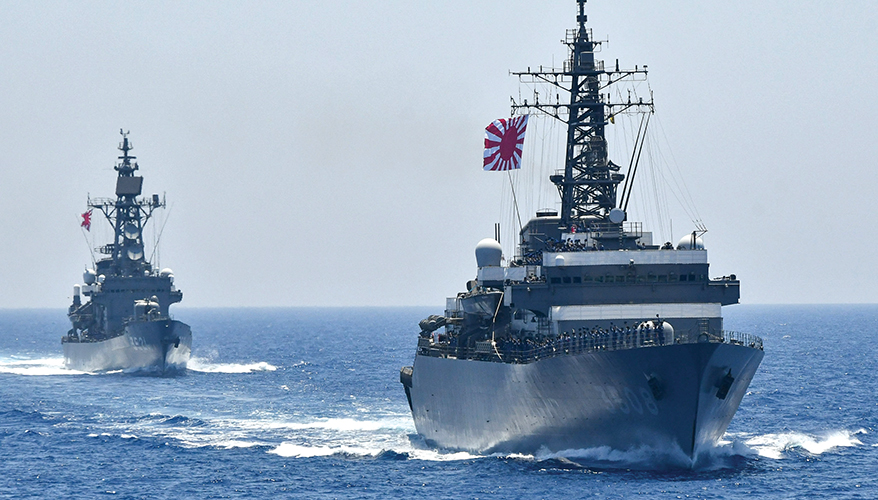Japan Looking to Increase Defense Ties With NATO
Japan Seeks Deeper Defense Ties with NATO

Standing NATO Maritime Group 2 ships conduct a passing exercise with ships from the Japan Maritime Self-Defense Force.
Defense Dept. photo
In October, North Korea launched a nuclear-capable ballistic missile over Japan, prompting evacuation alerts for Japanese citizens. The event was one of the five missile tests conducted by Pyongyang during a 10-day period, which came one week after the United States, South Korea and Japan conducted joint military exercises in the region.
The United States and Japan harshly condemned the launch, noting it was a danger to Japanese citizens, a violation of United Nations Security Council resolutions and “destabilizing to the region,” said a White House statement.
North Korea’s progress in developing and testing nuclear weapons, along with other global security concerns, has compelled Japan to shore up its own defense capabilities and draft new operational doctrines. As it looks to reinforce a free and open Indo-Pacific, Tokyo is also seeking a stronger relationship with NATO that benefits Japan’s defense needs and the alliance’s goals for global security.
Japan has been building its collaboration with NATO for a little more than a decade in order to discuss shared security challenges and promote defense collaboration. The country participated in a NATO summit for the first time when Japanese Prime Minister Fumio Kishida attended the alliance’s 2022 event in Madrid.
“As the international community stands at a crossroads in history, the participation of NATO’s Asia-Pacific partners, including Japan, in the NATO Summit expresses the realization that the security of Europe and of the Indo-Pacific is inseparable,” Kishida said during a speech at the summit.
Kishida signaled that Japan is looking to deepen its relationship with NATO further as a result of Russia’s invasion of Ukraine and ongoing challenges in the Indo-Pacific.
He cited Moscow’s threat to use nuclear weapons in Ukraine and North Korea’s nuclear advancements as areas of concern.
“Russian aggression against Ukraine is not a problem for Europe alone, but instead an outrageous act that undermines the very foundation of the international order,” he said, adding that the crisis in Ukraine could likewise happen in East Asia.
In response to the current global security climate, Japan is drafting a new national security strategy and updating policies that would boost defense spending. This will open doors for further cooperation with Japan’s international allies and partners, Kishida noted.
The Japanese Ministry of Defense has requested more than $40 billion for its fiscal year 2023 budget — the largest amount in the country’s history. The request had more than 100 items on a wish list, but without specific funding amounts. Those figures will come after the doctrine is published, according to budget documents.
The request outlined seven key areas of defense modernization priorities: stand-off defense, air-and-missile defense, unmanned vehicles, cross-domain operations, command and control, logistics and sustainability capabilities.
The technologies are not so different from some of NATO’s high visibility projects currently under development by member and partner nations — including multinational command-and-control systems, the Maritime Multi Mission Aircraft, unmanned sea vessels for mine clearing and tracking submarines and the Modular Ground Based Air Defense system.
In addition, the emergence of space and cyberspace as contested environments creates new opportunities for collaboration between Japan and NATO members that is not limited to geographic distance, said Jun Nagashima, adjunct professor at the National Defense Academy in Japan and former liaison officer to NATO and the European Union.
“As new domains become warfighting zones … the battlefield in which military forces operate will expand significantly,” he said through an interpreter during an event hosted by the International Security Industry Council of Japan.
These new warfighting domains call for more complex technologies that rely on data- and software-defined systems, he added.
NATO refers to modern capabilities like big data, artificial intelligence, autonomous systems and quantum computing as emerging and disrupting technologies, or EDTs. The alliance adopted an implementation strategy in 2021 to lay groundwork for how NATO can accelerate technological innovation in these areas while protecting them against adversary use, according to a NATO release.
Japan will need to ensure its interoperability with NATO as it bolsters its own capabilities if Tokyo hopes to strengthen its partnership with the alliance, Nagashima said.
“If gaps exist among the parties involved in the underlying technology, the premise of warfare will be lost and the equipment cooperation will become meaningless,” he said.
Japan has tried to achieve interoperability with NATO in recent years. For example, the country has participated in the committee responsible for promoting weaponry cooperation called the Conference of National Armaments Directors, or CNAD, said Liviu Lazar, industry relations coordinator at NATO.
Because the organization is responsible for joint capability requirements for systems across the alliance, “the organization is a primary tool for achieving interoperability of NATO forces,” Lazar said during the event. It also allows partner countries, such as Japan, to collaborate on equipment and research projects.
Japan has also been working with the alliance to address interoperability between platforms as part of NATO’s Partnership Interoperability Initiative since 2014, he said.
As one of the alliance’s interoperability partners, Japan could participate in the NATO Industrial Advisory Group, or NIAG.
The organization connects industry representatives from NATO members and some partner nations that can provide insights on the research, development and production for new capabilities that inform system competition phases, said Rudy Priem, director of government and NATO relations at Raytheon Technologies.
The group is already consulting on the Alliance Future Surveillance and Control program, with which NATO will replace the Boeing E-3 Sentry airborne warning and control aircraft, he noted.
Additionally, the advisory group’s discussions allow industry members to understand the alliance’s projections and needs for future operational environments, from command-and-control systems to next-generation aircraft, Priem said.
“If you’re involved in the NIAG in the pre-competition phase, you can receive that visibility and capability planning,” he said. “We exchange views of what might happen in the short term, midterm and long term, and that’s interesting for us as companies to start investing in certain equipment in the future or even production lines.”
Even though Tokyo has expressed its willingness to cooperate more with NATO in capability development, it is important to understand how other nonmembers have worked with the alliance in the past in order to mitigate risk for Japan, Nobushige Takamizawa, former ambassador of Japan to the conference on disarmament in Geneva, said through an interpreter during the event.
Previous examples of how non-NATO members and their industries have collaborated with the alliance — including success stories and failures — would be helpful for Japan to review, he added.
In addition, any defense cooperation between the alliance and Japan needs to be reciprocal, Takamizawa said.
“If it’s just a system to collect information for NATO, then there might be doubts as to whether it will help the various countries improve their defensive vulnerabilities,” he said. “That’s not a positive way of saying it, but I think it’s necessary to talk about benefits for non-NATO partners.”
Japan’s past participation with organizations within NATO gives the country a leg up as it looks for strengthened cooperation with the alliance, Lazar said.
“There is a huge difference between trying to establish relationships from a blank sheet of paper and having already a number of policy and political steps already performed that are actually paving the way for that relationship. … We are very far from starting from scratch,” he said.
The alliance has also emphasized the need to cooperate with nations in the Indo-Pacific, Lazar noted. At the NATO Brussels Summit in 2021, members agreed to increase political dialogue and collaboration between the alliance and partners in the region, including Japan, Australia, South Korea and New Zealand.
Meanwhile, military partnerships between Japan and individual NATO members — such as the United States and the United Kingdom — could also serve as a foundation for more robust cooperation with the alliance, Nagashima said.
The United States and Japan are strong military allies and in the past have co-developed and co-produced capabilities, such as the SM-3 Block IIA missile interceptor manufactured by Raytheon and Mitsubishi Heavy Industries. Tokyo is also a frequent purchaser of U.S.-made defense equipment, and the two nations’ armed forces frequently conduct joint exercises.
“From the U.S. perspective, they’re looking East and West to Europe and Japan,” Nagashima said. “I see it as a triangle, with the [United States] at the center for interoperability.”
Both countries are part of the Quadrilateral Security Dialogue along with Australia and India. The four nations are moving to enhance technology collaboration as concerns about China’s assertiveness in the Indo-Pacific grow.
Japan has also recently entered a new partnership with the United Kingdom to collaborate as the countries develop their sixth-generation aircraft — the F-X and Tempest jet fighter, respectively. The nations plan to combine efforts by learning from one another as they develop, while also hoping to cut costs.
While collaborations like this are conducted bilaterally or in a coalition of countries outside of the alliance, “it’s good for NATO that all of these people are working together and bringing equipment to NATO,” Priem said.
Ultimately, the extent of Japan’s cooperation with NATO will have to be defined in the nation’s new national security strategy, due for publication by the end of 2022, Takamizawa said. The upcoming documents should also include guidance on how Japan can securely share defense information with NATO — and vice versa, he added.
“We need materials to help us understand them. Once you’ve understood the process … we have to clarify both,” Takamizawa said. “In any event, political leadership and industry leadership are both necessary.”
Topics: International, Global Defense Market
" Conservative News Daily does not always share or support the views and opinions expressed here; they are just those of the writer."




